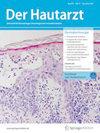【人体皮肤的防晒:从A到Z】。
4区 医学
Q3 Medicine
引用次数: 1
摘要
太阳辐射含有约6.8%的紫外线。紫外线辐射仍然被认为是非黑色素瘤皮肤癌(NMSC;主要是基底细胞癌和鳞状细胞癌)和恶性黑色素瘤(MM)。为了避免诱导和持续紫外线诱导的突变,我们的皮肤配备了内源性保护机制,如诱导细胞周期阻滞、修复机制、免疫监视和启动各种类型的细胞死亡。外源性防晒包括一系列行为,如避免过度暴露在阳光下,穿防紫外线衣服和适当使用局部防晒霜。本文章由计算机程序翻译,如有差异,请以英文原文为准。
[Sun protection of human skin: from A to Z].
Solar radiation contains about 6.8% ultraviolet (UV) radiation. UV radiation is still regarded as one of the most important risk factors for both nonmelanoma skin cancer (NMSC; predominantly basal cell carcinoma and squamous cell carcinoma) and malignant melanoma (MM). To avoid induction and persistence of UV-induced mutations, our skin is armed with an arsenal of endogenous protective mechanisms such as induction of cell cycle arrest, repair mechanisms, immunosurveillance and the initiation of various types of cell death. Exogenous sun protection includes a range of behaviors such as avoiding extensive sun exposure, wearing UV-proof clothing and appropriate application of topical sunscreens.
求助全文
通过发布文献求助,成功后即可免费获取论文全文。
去求助
来源期刊

Hautarzt
医学-皮肤病学
CiteScore
1.40
自引率
0.00%
发文量
93
审稿时长
4-8 weeks
期刊介绍:
Der Hautarzt is an internationally recognized journal informing all dermatologists working in practical or clinical environments about important developments in the field of dermatology including allergology, venereology and related areas.
Comprehensive reviews on a specific topical issue focus on providing evidenced based information on diagnostics and therapy.
Freely submitted original papers allow the presentation of important clinical studies and serve the scientific exchange.
Case reports feature interesting cases and aim at optimizing diagnostic and therapeutic strategies.
Review articles under the rubric "Continuing Medical Education" present verified results of scientific research and their integration into daily practice.
 求助内容:
求助内容: 应助结果提醒方式:
应助结果提醒方式:


